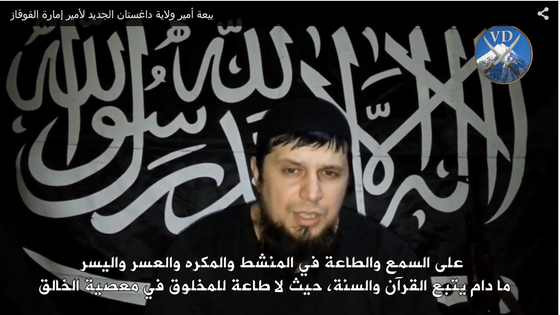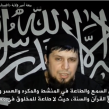
Caucasus Emirate Loyalist Picked as New Militant Leader in Dagestan
Publication: Eurasia Daily Monitor Volume: 12 Issue: 32
By:

Sheikh Ali Abu-Muhammad has been the amir (leader) of the Caucasus Emirate (CE) since March 2014 (Kavkazsky Uzel, December 28, 2014). Now, Abu-Muhammad, who is number 1,642 on the Russian Service for Financial Monitoring list of terrorists (Fedsfm.ru, accessed February 20), is trying to restore control over the organization in Dagestan after multiple amirs who used to form the basis of the Dagestani jamaat left the CE (see EDM, January 30).
The CE’s leader has recently managed to convince a well-known commander of the Gimry group, 36-year-old amir Said Abu Muhammad Arakansky (Kamil Saidov), to stay under his command. Arakansky pledged allegiance to the Caucasus Emirate and Abu-Muhammad in the capacity of the leader of Velayat Dagestan (YouTube, February 17). Besides taking the oath himself, Arakansky also addressed those militants who had taken an oath of allegiance to the leader of the Islamic State (IS) organization, Abu Bakr al-Baghdadi. Calling those militants brothers, Arakansky asked them to abstain from splitting the militancy and to return under the command of the Caucasus Emirate’s leader. According to the militant from Gimry, the split in the ranks of the Dagestani fighters weakened the insurgency and played into the hands of their enemies. In his two-minute address, Arakansky managed to do two things: take an oath of allegiance and leave the door open to those who used to be his associates in the struggle against the Russian government in the North Caucasus—in particular, in Dagestan.
The appointment of Said Abu Muhammad Arakansky as the new leader of the Dagestani jamaat under the command of the CE should not be surprising. Even though Russian experts said that he is a new person unknown to them (Kavkazsky Uzel, December 30, 2014), Arakansky is far from a novice. The new amir of Dagestan is considered to be the CE’s leader close associate. Abu-Muhammad has promoted Arakansky for the past two years and protected him from foes. Even at the time when Abu-Muhammad was still the qadi (judge) of the Caucasus Emirate, he shielded Arakansky from the Buinaksk militants’ criticism. In 2013, Abu-Muhammad tried to push aside one of the best known Dagestani militants, the leader of the Buinaksk jamaat, amir Seifulla (Bammatkhan Sheikhov) (Kavpolit.com, August 20, 2013). However, his attempt fell through since the militants of the Buinaksk jamaat themselves defended their amir (Dailymotion.com, December 12, 2014).
Therefore, the new amir of Velayat Dagestan, Said Abu Muhammad Arakansky, has been a notable figure in the Dagestani insurgency and it is difficult to call him a novice. Arakansky quickly rose to prominence within the CE as he successfully captured the position of the leader of the Dagestani jamaat. The new leader of the Dagestani militants is also known for his extraterritoriality, as he occupied leadership positions among other groups of militants outside his hometown. Arakansky comes from the capital of Dagestan, Makhachkala, but he led the Gimry jamaat in Dagestan’s Untsukul district for some time and also agreed to lead the Temir Khan Shurinsky jamaat in the Buinaksk area. Thus, the new leader of the Dagestani jamaat was not tied up in one part of the republic, but served everywhere he was dispatched by the leadership of the CE.
It is worth noting that Arakansky was also close to Abu Muhammad (Rustam Asilderov), the previous leader of the Dagestani jamaat who left the CE and pledged allegiance to the IS. The militants who were unhappy with Asilderov naturally chose to remain in the CE. Asilderov leads the splinter group of North Caucasus militants that left the CE. Some groups of militants in the CE disliked Asilderov when he was still one of the leaders of the organization, but the second man in the splinter group, Abu Muhammad Agachaulsky (Arslanali Kambulatov), is an insurgent leader respected by practically all the militants in both camps, the CE and the IS. Agachaulsky is the leader of the Shamilkala Sector of the Dagestani insurgency. Informally, he might be the most authoritative person in the new splinter group of the IS. However, Said Abu Muhammad Arakansky has strained relations with this influential militant. In 2014, the groups of Agachaulsky and Arakansky operated in Makhachkala practically independently from each other.
It remains unclear why it took Said Abu Muhammad Arakansky nearly two months after his appointment as the amir of Dagestan in December 2014 to pledge allegiance to the Caucasus Emirate. Apparently, the issue that has split the North Caucasian militants—whether to associate with the Caucasus Emirate or the IS—remains highly controversial for the Dagestani militants.
The latest events indicate that it is too early to declare the idea of the Caucasus Emirate dead. However, the disintegration of the Caucasus Emirate has been so intense that it is unlikely it will survive in its current form for long. Potentially, a unifying idea uniting the CE and the IS might emerge in response to the need for coordination. The crisis in the Caucasus Emirate is still unfolding.




